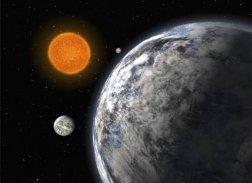Some of the raw materials for life, it seems, come from space, according to a new analysis of an Australian meteorite, writes National Geographic.

|
| ©N/A |
The scientists found organic molecules of uracil and xanthine in the meteorite, and confirmed that they were not formed on earth. Those molecules are called nucleobases, and are the ancestor (more basic form of) DNA - a set of genetic instructions for organisms on Earth. Uracil and xanthine are most probably the basis for RNA which builds proteins in organisms.
The Life systems that formed on earth might have adapted the nucleobases from meteor fragments, and used them as early and primitive genetic material, which enabled them to carry over all of their genetic information to the next generation - said Zita Martins from London's Imperial College.
Asteroid as old as the Solar System

|
| ©N/A |
The discoveries of this research supports the idea that was first publicly presented by the astronomer Carl Sagan in 1992. He was convinced that some of the building blocks that are key for life were created in stray comets and asteroids who "planted" them throughout space.
It is totally possible that those molecules landed at the right place at the right time, and helped create life as it is today on Earth said Max Bernstein, commenting the new discoveries of his colleagues in London. Max is an astro-chemist for NASA.
Scientists analyzed a fragment of an asteroid that fell in Australia back in 1969, for which it is estimated that it is around 4.5 billion years old, which is the age of our Solar System. The results of the analysis showed that the nucleobases from the meteorite contain large amounts of a heavy type of carbon that rarely appears on earth.
Zita Martins believes that those nucleobases formed in space or in the inside of an asteroid where they were protected from strong ultra-violet rays and other radiation.
Extra-terrestrial life

|
| ©N/A |
One of those "space hitchhikers" could have ended up on earth, in the period between 3.8 to 4.5 billion years ago when the Solar System was a hectic place, and Earth was often the victim of aggressive attacks by comets and asteroids. An alternate theory is that those nucleobases could have formed independently on earth, but the latest studies show that the conditions on Earth were too harsh for this, and that something like that was nearly impossible.
These new discoveries confirm something that most scientists have suspected for a long time. Knowing that the molecules formed in space and that they can travel to a planet is of great importance, because it suggests that some of the ancestors of DNA came to Earth from space before, after and during the creation of life on earth and its evolution - considers Bernstein.
New information also points towards extra-terrestrial life, because meteorites are most probably not building blocks that were brought exclusively to Earth, but to other planets as well. These meteorites were created not long after the birth of our solar system, so that it is possible that these molecules are spread throughout space - considers Martins.



Reader Comments
to our Newsletter